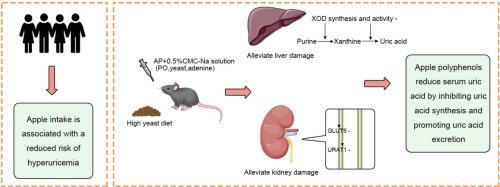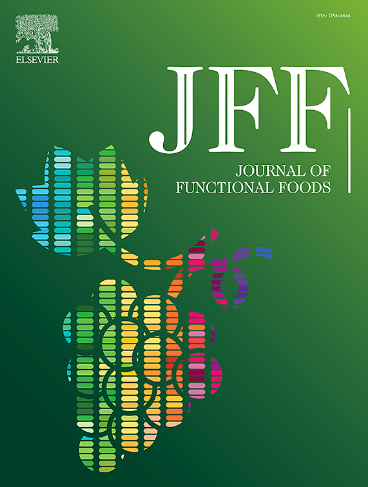苹果多酚通过抑制黄嘌呤氧化酶和促进尿酸排泄来缓解高尿酸血症
IF 4
2区 农林科学
Q2 FOOD SCIENCE & TECHNOLOGY
引用次数: 0
摘要
高尿酸血症是一种由过量尿酸积累引起的代谢紊乱,是痛风和相关肾损害的主要危险因素。目前的药物治疗往往有副作用,强调需要更安全的替代品。本研究探讨了苹果多酚(AP)在高尿酸血症治疗中的预防和治疗潜力及其机制。对15121名中国大学生的横断面分析显示,苹果消费与高尿酸血症风险呈负相关(OR = 0.86; 95% CI: 0.73-0.99; P = 0.028)。用氧酸钾和腺嘌呤建立高尿酸血症小鼠模型21 d, AP处理通过抑制黄嘌呤氧化酶的活性和表达,下调肾尿酸转运蛋白URAT1和GLUT9,显著降低血清尿酸水平。组织病理学分析表明,AP可减轻高尿酸血症引起的肾和肝损害。这些发现强调了AP对尿酸合成和排泄的双重调节作用,为其作为高尿酸血症管理的自然饮食干预的潜力提供了新的见解。本文章由计算机程序翻译,如有差异,请以英文原文为准。

Apple polyphenols alleviate hyperuricemia by inhibiting xanthine oxidase and promoting uric acid excretion
Hyperuricemia, a metabolic disorder caused by excessive uric acid accumulation, is a major risk factor for gout and related kidney damage. Current pharmacological treatments often have side effects, emphasizing the need for safer alternatives. This study investigated the preventive and therapeutic potential of apple polyphenols (AP) in hyperuricemia management, as well as the underlying mechanisms. A cross-sectional analysis of 15,121 Chinese undergraduates revealed that apple consumption was inversely associated with hyperuricemia risk (OR = 0.86; 95 % CI: 0.73–0.99; P = 0.028). A hyperuricemia mouse model was established by potassium oxonate and adenine for 21 days, and AP treatment significantly reduced serum uric acid levels by inhibiting both the activity and expression of xanthine oxidase, and by downregulating renal uric acid transporters URAT1 and GLUT9. Histopathological analysis indicated that AP alleviated kidney and liver damage caused by hyperuricemia. These findings highlight the dual regulatory effect of AP on uric acid synthesis and excretion, providing new insights into its potential as a natural dietary intervention for hyperuricemia management.
求助全文
通过发布文献求助,成功后即可免费获取论文全文。
去求助
来源期刊

Journal of Functional Foods
FOOD SCIENCE & TECHNOLOGY-
CiteScore
9.60
自引率
1.80%
发文量
428
审稿时长
76 days
期刊介绍:
Journal of Functional Foods continues with the same aims and scope, editorial team, submission system and rigorous peer review. We give authors the possibility to publish their top-quality papers in a well-established leading journal in the food and nutrition fields. The Journal will keep its rigorous criteria to screen high impact research addressing relevant scientific topics and performed by sound methodologies.
The Journal of Functional Foods aims to bring together the results of fundamental and applied research into healthy foods and biologically active food ingredients.
The Journal is centered in the specific area at the boundaries among food technology, nutrition and health welcoming papers having a good interdisciplinary approach. The Journal will cover the fields of plant bioactives; dietary fibre, probiotics; functional lipids; bioactive peptides; vitamins, minerals and botanicals and other dietary supplements. Nutritional and technological aspects related to the development of functional foods and beverages are of core interest to the journal. Experimental works dealing with food digestion, bioavailability of food bioactives and on the mechanisms by which foods and their components are able to modulate physiological parameters connected with disease prevention are of particular interest as well as those dealing with personalized nutrition and nutritional needs in pathological subjects.
 求助内容:
求助内容: 应助结果提醒方式:
应助结果提醒方式:


